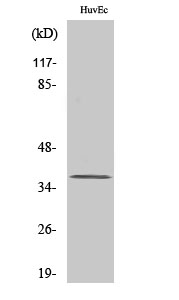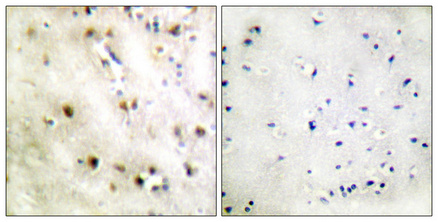

| WB | 1/500-1/1000 | Human,Mouse,Rat |
| IF | 咨询技术 | Human,Mouse,Rat |
| IHC | 1/50-1/100 | Human,Mouse,Rat |
| ICC | 技术咨询 | Human,Mouse,Rat |
| FCM | 咨询技术 | Human,Mouse,Rat |
| Elisa | 1/10000 | Human,Mouse,Rat |
| Aliases | ZFP36L1; BERG36; BRF1; ERF1; RNF162B; TIS11B; Zinc finger protein 36; C3H1 type-like 1; Butyrate response factor 1; EGF-response factor 1; ERF-1; Protein TIS11B |
| Entrez GeneID | 677 |
| WB Predicted band size | Calculated MW: 36 kDa; Observed MW: 36 kDa |
| Host/Isotype | Rabbit IgG |
| Antibody Type | Primary antibody |
| Storage | Store at 4°C short term. Aliquot and store at -20°C long term. Avoid freeze/thaw cycles. |
| Species Reactivity | Human,Mouse,Rat |
| Immunogen | The antiserum was produced against synthesized peptide derived from human TISB. AA range:58-107 |
| Formulation | Purified antibody in PBS with 0.05% sodium azide,0.5%BSA and 50% glycerol. |
+ +
以下是关于ZFP36L1抗体的3篇示例参考文献(注:以下文献为示例性内容,实际引用时请核实真实文献信息):
---
1. **文献名称**: *ZFP36L1 regulates maternal mRNA stability during oocyte development*
**作者**: Vogel, K.L., et al.
**摘要**: 研究利用ZFP36L1抗体在小鼠卵母细胞中进行免疫荧光和Western blot分析,发现ZFP36L1通过结合特定mRNA的3'UTR调控其稳定性,对生殖细胞发育至关重要。
2. **文献名称**: *The role of ZFP36L1 in T-cell activation and cytokine production*
**作者**: Galloway, A., et al.
**摘要**: 通过ZFP36L1抗体在T细胞裂解物中的免疫沉淀实验,揭示了该蛋白通过降解促炎细胞因子mRNA(如TNF-α)负向调控T细胞过度活化,为自身免疫疾病机制提供新见解。
3. **文献名称**: *ZFP36L1 suppresses leukemogenesis by targeting oncogenic transcripts*
**作者**: Hodson, D.J., et al.
**摘要**: 研究采用ZFP36L1抗体进行组织芯片(IHC)和流式细胞术,证明其在急性髓系白血病中低表达,并通过降解癌基因相关mRNA抑制肿瘤进展,提示其作为潜在治疗靶点。
---
**备注**:若需实际文献,建议通过PubMed或Web of Science以关键词“ZFP36L1 antibody”、“ZFP36L1 function”检索,并筛选涉及实验方法(如Western blot、IP、IHC)的研究。
The ZFP36L1 antibody is a crucial tool for studying the ZFP36L1 protein, a member of the TIS11 family of RNA-binding proteins. ZFP36L1 (also known as TIS11B, ERF-1. or BRF1) functions as a post-transcriptional regulator by binding to AU-rich elements (AREs) in the 3' untranslated regions of target mRNAs, promoting their degradation and fine-tuning gene expression. It plays vital roles in cellular processes such as proliferation, differentiation, apoptosis, and immune responses, with implications in cancer, inflammation, and developmental disorders.
Antibodies targeting ZFP36L1 are widely used in research to detect protein expression levels, subcellular localization (predominantly cytoplasmic), and interactions with RNA or partner proteins. They are essential in techniques like Western blotting, immunoprecipitation, immunofluorescence, and immunohistochemistry. Many commercially available ZFP36L1 antibodies are raised against specific epitopes, often within its conserved tandem zinc-finger domains. Validation typically includes knockout cell lines or tissues to confirm specificity.
Research utilizing these antibodies has shed light on ZFP36L1's regulatory roles, such as controlling T-cell activation, maintaining hematopoietic stem cell quiescence, and suppressing tumorigenesis. Dysregulation of ZFP36L1 is linked to diseases like leukemia and autoimmune conditions, making its study clinically relevant. Ongoing efforts focus on optimizing antibody performance across experimental models and human samples.
×